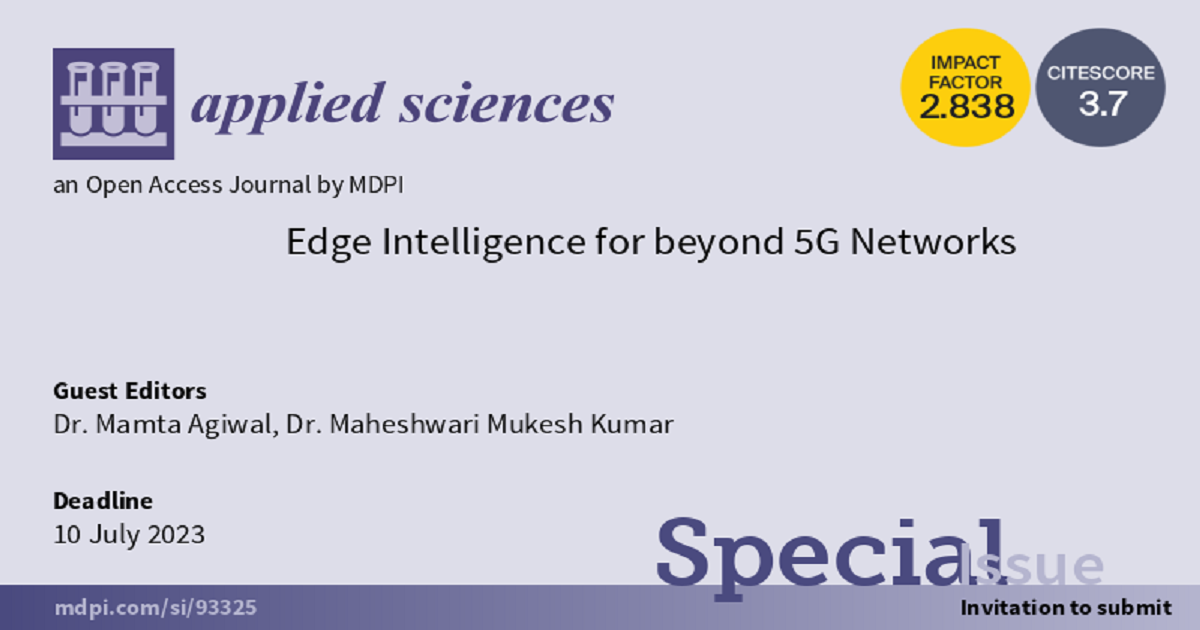Edge Intelligence for beyond 5G Networks
A special issue of Applied Sciences (ISSN 2076-3417). This special issue belongs to the section "Electrical, Electronics and Communications Engineering".
Deadline for manuscript submissions: closed (10 July 2023) | Viewed by 10637

Special Issue Editors
Interests: 5G; B5G; random access; IoT; DRX; paging
Special Issue Information
Dear Colleagues,
With the 5G research already maturing towards global standardization, the focus is now shifting towards Beyond-5G (B5G) developments. The capabilities of B5G wireless communication are expected to be much higher, and are mostly driven by millions of connected devices and intensive services and applications. The wireless devices (smart terminals, IoT devices, sensors, video cameras, etc.) that generate several hundred observations and several terabytes of data are located at the edge of the network. Edge intelligence (EI), powered by artificial intelligence (AI) techniques (machine learning, deep neural networks, etc.), offers to provide powerful computational processing, massive data acquisition, and edge-caching capabilities at the proximity to the end users. B5G networks when empowered by AI systems at the edge networks can enable better insight into the dynamics of the operating environment, which would result in an effective management of resources. AI-empowered efficient resource scheduling strategies in turn can support the ultra-high reliability and ultra-low latency requirements of several novel applications of B5G networks, such as AR/VR services, self-driving cars, intelligent transport, Industry 4.0, and extensive surveillance. Edge intelligence for B5G networks has the potential to drive future data-intensive applications and services.
This new paradigm of edge-intelligence-empowered B5G presents several research opportunities. In this Special Issue we are pleased to invite topics that address challenges in edge intelligence as the crucial technology in B5G networks. The Special Issue aims to highlight the latest concepts, implementations, and applications in the field of edge intelligence for B5G networks. Original research articles and reviews are welcome. Research areas may include (but are not limited to) the following:
- Frameworks and models for edge-intelligence-empowered B5G;
- AI empowered edge-cloud architecture for B5G;
- Concepts and protocols for edge intelligence empowered B5G;
- Edge computation, communication, caching, and control in B5G;
- Edge intelligence for computation offloading in B5G;
- Edge intelligence for caching and storage in B5G;
- Reinforcement learning approaches for edge-intelligent B5G;
- Networking between edge nodes for resource scheduling;
- Resource optimization for edge-intelligence-empowered B5G;
- Network traffic prediction and control in edge-intelligent B5G;
- Energy efficiency and greenness–performance tradeoff for edge-intelligent B5G;
- Security and privacy in edge-intelligent B5G;
- Use cases/applications highlighting the potential of edge intelligence for B5G.
Dr. Mamta Agiwal
Dr. Maheshwari Mukesh Kumar
Guest Editors
Manuscript Submission Information
Manuscripts should be submitted online at www.mdpi.com by registering and logging in to this website. Once you are registered, click here to go to the submission form. Manuscripts can be submitted until the deadline. All submissions that pass pre-check are peer-reviewed. Accepted papers will be published continuously in the journal (as soon as accepted) and will be listed together on the special issue website. Research articles, review articles as well as short communications are invited. For planned papers, a title and short abstract (about 100 words) can be sent to the Editorial Office for announcement on this website.
Submitted manuscripts should not have been published previously, nor be under consideration for publication elsewhere (except conference proceedings papers). All manuscripts are thoroughly refereed through a single-blind peer-review process. A guide for authors and other relevant information for submission of manuscripts is available on the Instructions for Authors page. Applied Sciences is an international peer-reviewed open access semimonthly journal published by MDPI.
Please visit the Instructions for Authors page before submitting a manuscript. The Article Processing Charge (APC) for publication in this open access journal is 2400 CHF (Swiss Francs). Submitted papers should be well formatted and use good English. Authors may use MDPI's English editing service prior to publication or during author revisions.
Keywords
- B5G
- Artificial Intelligence (AI)
- machine learning
- Indistry 4.0
- caching
- resource optmization
- energy efficiency





